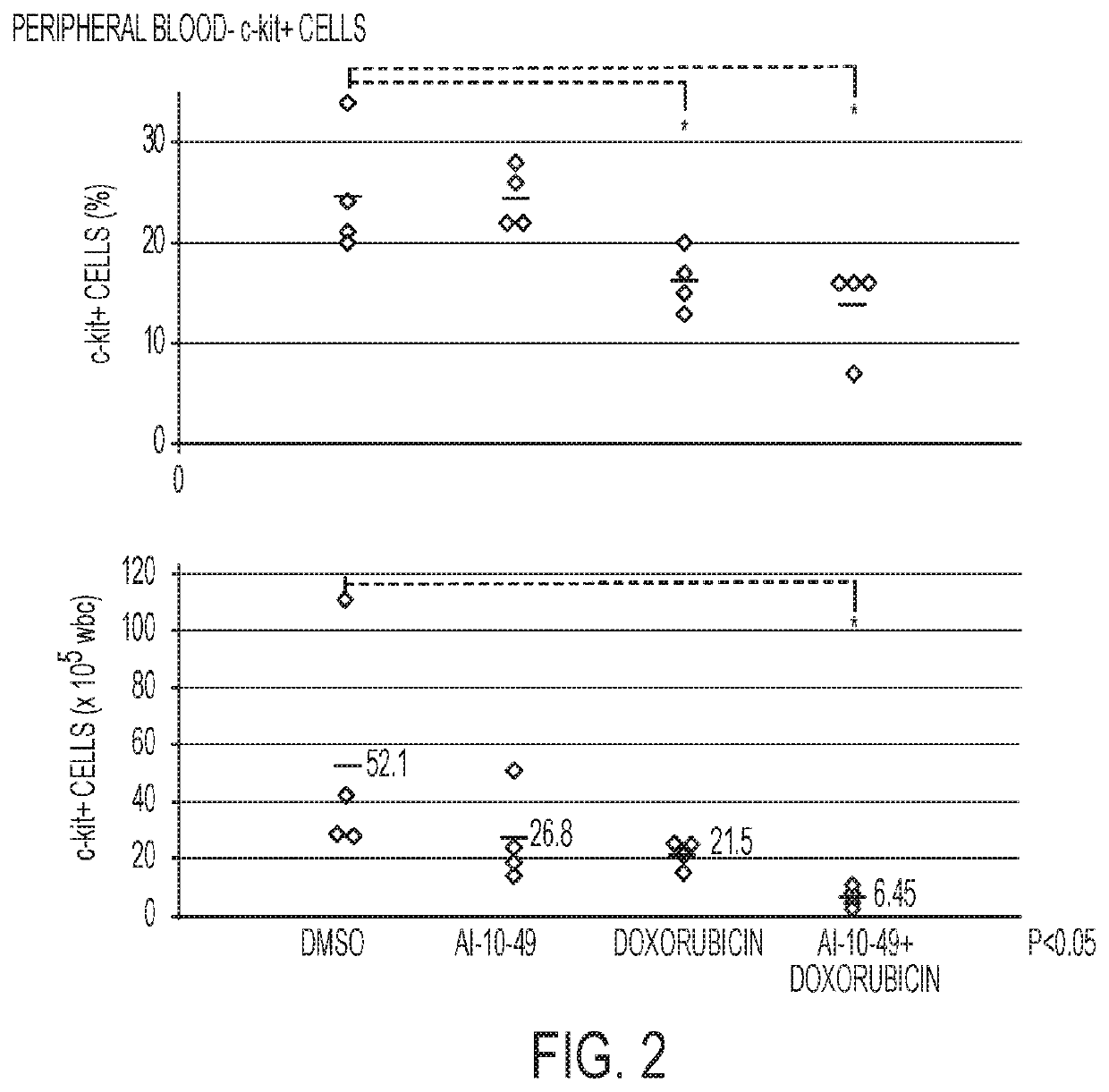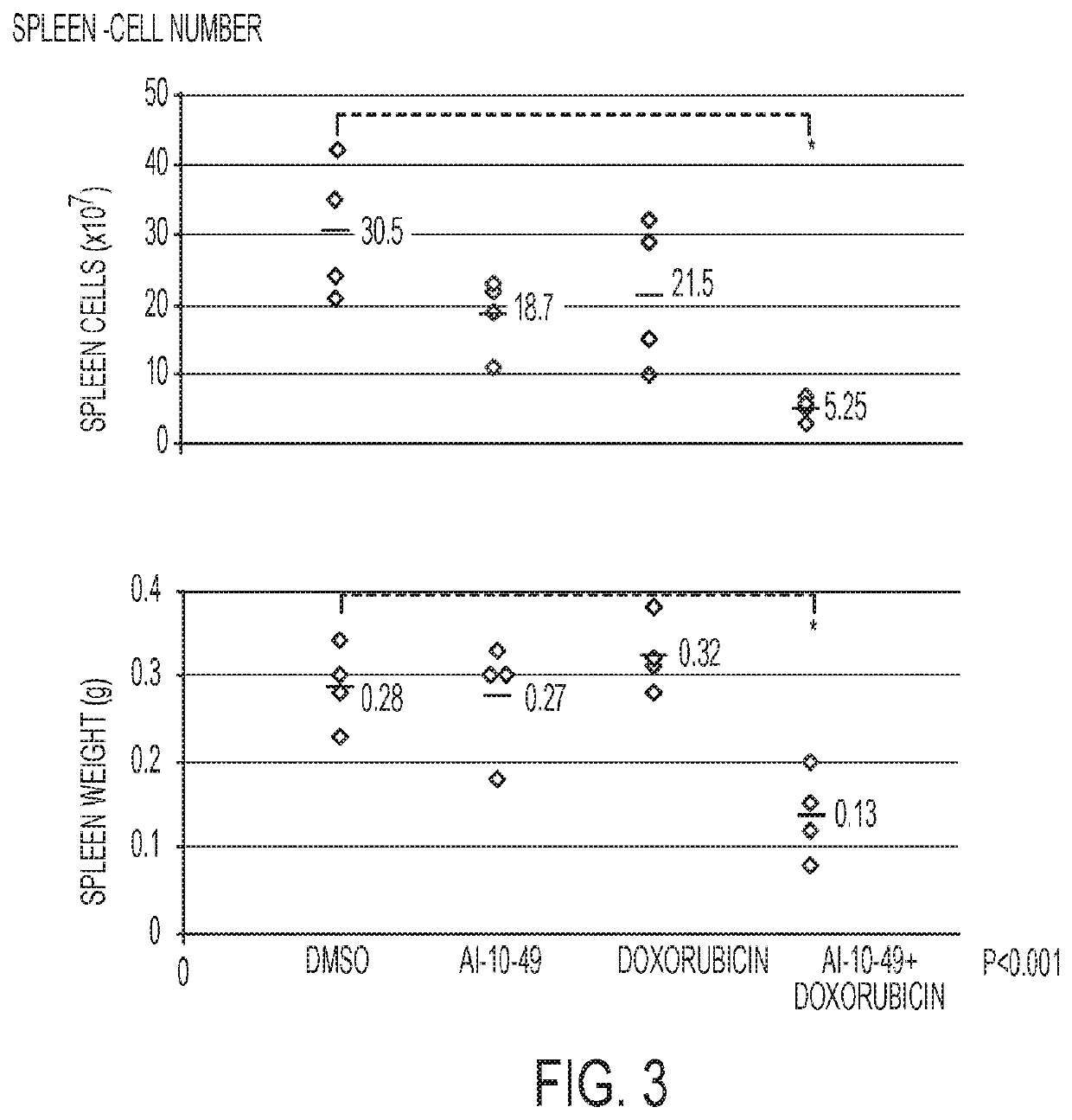Combination therapies for treating cancer
a combination therapy and cancer technology, applied in the field of cancer chemotherapy, can solve the problems of limited long-term survival, low success probability of targeting such interactions, and inability to be well tolerated by the predominantly older patient population, and achieve the effect of inhibiting the proliferation of inv(16) leukemia cells
- Summary
- Abstract
- Description
- Claims
- Application Information
AI Technical Summary
Benefits of technology
Problems solved by technology
Method used
Image
Examples
example 1
Transplantation Studies in Mice
[0081]The experiments with animals were performed in accordance with a protocol reviewed and approved by the University of Massachusetts Institutional Animal Care and Use Committee. An efficient mouse model of inv(16)AML was used. (L. Xue, et al., 2014.) Leukemic cells carrying Cbfb+ / MYH11 and Nras+ / G12D oncogenic alleles were generated in CD45.2 C57BL / 6 mice, as previously described (Illendula, et al., 2015.) Briefly, 2×103 Cbfb+ / MYH11; Nras+ / G12D leukemic cells were transplanted into each of 16 sub-lethally irradiated six to eight-week-old CD45.1 C57BL / 6 female mice. Five days post-transplant, mice were placed in 4 groups with 4 mice in each group: DMSO (control, 50 μL), Dox, AI-10-49, and Dox+AI-10-49. Both Dox groups received a single dose of doxorubicin (2 mg / kg) 5 days post-transplant. Both AI-10-49 groups received a daily dose of AI-10-49 (200 mg / kg) in DMSO injected intraperitoneally for 10 days. After this 10-day period, all mice were sacrific...
example 2
n the Proliferation of the Inv(16)+ Cell Line ME-1
[0087]ME-1 cells (Inv(16)+)(DSMZ, Germany) were cultured in RPMI 1640 with 20% fetal bovine serum, and 25 mM HEPES. 5×105 ME-1 cells were cultured for 24 hours in DMSO, or different combinations with differing order of addition as indicated, using 96 well plates. Cells were incubated for a total of 4 days and proliferation was measured using the MTT kit, CellTiter 96® AQueous One Solution (Promega, Pa.). Compounds were added day 1 alone, day 2 alone, or both on day 1 to assess any effect of the timing of the combination. The experiments were replicated at least 2 times.
[0088]As shown in FIG. 5, synergy for the combination of AI-10-49+doxorubicin added simultaneously as well as for addition of AI-10-49 followed by doxorubicin on the second day was observed. Whereas addition of doxorubicin followed by AI-10-49 showed inhibition comparable to each component added separately.
example 3
of N-methyl-2-((6-(5-(trifluoromethoxy)-1H-benzo[d]imidazol-2-yl)pyridin-3-yl)oxy)-N-(2-((6-(5-(trifluoromethoxy)-1H-benzo[d]imidazol-2-yl)pyridin-3-yl)oxy)ethyl)ethan-1-amine, (AI-14-124)
[0089]The synthesis was achieved in two steps by previously described methods. (Illendula, et al., 2015.) In step 1, dialdehyde, 5,5′-(((methylazanediyl)bis(ethane-2,1-diyl))bis(oxy))dipicolinaldehyde (AI-14-118), was synthesized from commercially available intermediates, 5-hydroxypicolinaldehyde and 2-chloro-N-(2-chloroethyl)-N-methylethan-1-amine. The aldehyde thus synthesized was carried to next step. In Step 2, AI-14-124 was synthesized from nitroaniline (0.22 g, 1 mmol) and dialdehyde AI-14-118 (0.16 g, 0.5 mmol), in good yield (0.13 g, 40%). mp 139-142° C.; 1H NMR (800 MHz, CD3OD-d4): δ 2.54 (3H, s), 3.03-3.04 (2H, t), 4.30-4.31 (2H, t), 7.11 (1H, s), 7.40-7.60 (3H, m), 8.13-8.14 (1H, d, J=8.64 Hz), 8.36 (1H, d, J=3.3 Hz); 13C NMR (800 MHz, CD3OD-d4): δ 44.00, 57.40, 68.05, 105.91, 112.15, 11...
PUM
| Property | Measurement | Unit |
|---|---|---|
| weight | aaaaa | aaaaa |
| weight ratio | aaaaa | aaaaa |
| pharmaceutical composition | aaaaa | aaaaa |
Abstract
Description
Claims
Application Information
 Login to View More
Login to View More - R&D
- Intellectual Property
- Life Sciences
- Materials
- Tech Scout
- Unparalleled Data Quality
- Higher Quality Content
- 60% Fewer Hallucinations
Browse by: Latest US Patents, China's latest patents, Technical Efficacy Thesaurus, Application Domain, Technology Topic, Popular Technical Reports.
© 2025 PatSnap. All rights reserved.Legal|Privacy policy|Modern Slavery Act Transparency Statement|Sitemap|About US| Contact US: help@patsnap.com



